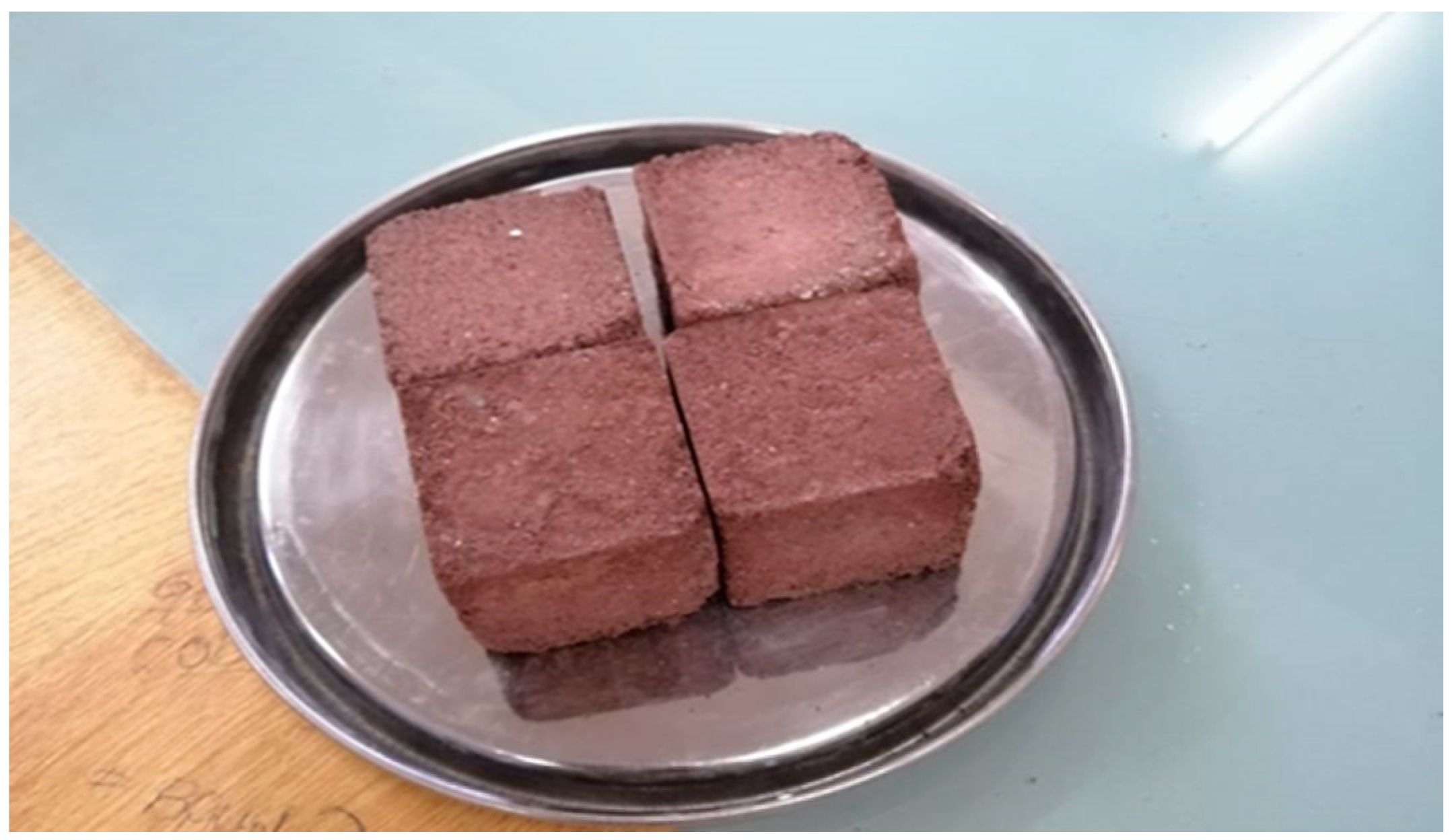Utilizing Corn Cob Ash and Bauxite as One-Part Geopolymer: A Sustainable Approach for Construction Materials †
Abstract
:1. Introduction
2. Research Methodology
2.1. Materials Preparation
2.2. Mortar Preparation
2.3. Curing
2.4. Tests
3. Results
3.1. Sieve Analysis of Fine Aggregates
3.2. Temperature of the Mortar
3.3. Setting Time of the Mortar
3.4. Compressive Strength
3.5. Cracks
4. Conclusions
- One-part geopolymer can be developed locally in Pakistan by using corn cob ash and bauxite.
- The mix design with 20 percent corn cob ash and 80 percent bauxite gave the most optimum results.
- One-part geopolymer resulting from corn cob ash and bauxite has huge potential for replacing OPC.
- The geopolymer developed in this research has compressive strength higher than that of normal ordinary Portland cement.
Author Contributions
Funding
Institutional Review Board Statement
Informed Consent Statement
Data Availability Statement
Acknowledgments
Conflicts of Interest
References
- Singh, R.P.; Vanapalli, K.R.; Cheela, V.R.S.; Peddireddy, S.R.; Sharma, H.B.; Mohanty, B. Fly Ash, GGBS, and silica fume based geopolymer concrete with recycled aggregates: Properties and environmental impacts. Constr. Build. Mater. 2023, 378, 131168. [Google Scholar] [CrossRef]
- Lyddon, C. Focus on Pakistan. WorldGrain, 20-Sep-2021. Available online: https://www.world-grain.com/articles/15862-focus-on-pakistan (accessed on 7 May 2023).
- Adesanya, D.A.; Raheem, A.A. Development of corn cob ash blended cement. Constr. Build. Mater. 2009, 23, 347–352. [Google Scholar] [CrossRef]
- Ye, J.; Zhang, W.; Shi, D. Effect of elevated temperature on the properties of geopolymer synthesized from calcined ore-dressing tailing of bauxite and ground-granulated blast furnace slag. Constr. Build. Mater. 2014, 69, 41–48. [Google Scholar] [CrossRef]
- ASTM C136-05; Standard Test Method for Sieve Analysis of Fine and Coarse Aggregates. ASTM: West Conshohocken, PA, USA, 2017. Available online: https://www.astm.org/c0136-05.html (accessed on 31 May 2023).
- ASTM C1064/C1064M; Standard Test Method for Temperature of Freshly Mixed Hydraulic-Cement Concrete. ASTM: West Conshohocken, PA, USA, 2017. Available online: https://www.astm.org/c1064_c1064m-17.html (accessed on 31 May 2023).
- ASTM C191; Standard Test Methods for Time of Setting Hydraulic Cement by Vicat Needle--eLearning Course. ASTM: West Conshohocken, PA, USA, 2010. Available online: https://www.astm.org/astm-tpt-185.html (accessed on 31 May 2023).
- ASTM C143/C143M; Standard Test Method for Slump of Hydraulic-Cement Concrete. ASTM: West Conshohocken, PA, USA, 2015. Available online: https://www.astm.org/c0143_c0143m-12.html (accessed on 31 May 2023).
- ASTM C109/C109M; Standard Test Method for Compressive Strength of Hydraulic Cement Mortars (Using 2-in. or [50-mm] Cube Specimens). ASTM: West Conshohocken, PA, USA, 2020. Available online: https://www.astm.org/c0109_c0109m-20.html (accessed on 31 May 2023).

| Material | Percentage by Weight (%) |
|---|---|
| CCA | 10, 20, 30 percent weight of binder |
| Bauxite | 90, 80, 70 percent weight of binder |
| Sand | 50 |
| Activator (Sodium Silicate) | 10% the weight of binder |
| Water-to-Binder Ratio | 0.3 |
| Super Plasticizer | 2% the weight of binder |
| Sample ID | Initial Setting Time (min) |
|---|---|
| C10B90 | 40 |
| C20B80 | 60 |
| C30B70 | 75 |
| OPC | 35 |
| GM Mix | Compressive Strength at Different Curing Ages (MPa) | |||||
|---|---|---|---|---|---|---|
| 7 Days | % Difference in Compressive Strength as Compared to OPC | 14 Days | % Difference in Compressive Strength as Compared to OPC | 28 Days | % Difference in Compressive Strength as Compared to OPC | |
| C10B90 | 16.5 | 43.47 | 18.2 | 51.67 | 19.5 | 52.32 |
| C20B80 | 18.1 | 57.39 | 19.6 | 63.34 | 20.76 | 62.18 |
| C30B70 | 14.3 | 24.34 | 15.5 | 29.17 | 17.2 | 34.37 |
| OPC | 11.5 | Nil | 12.0 | Nil | 12.80 | Nil |
Disclaimer/Publisher’s Note: The statements, opinions and data contained in all publications are solely those of the individual author(s) and contributor(s) and not of MDPI and/or the editor(s). MDPI and/or the editor(s) disclaim responsibility for any injury to people or property resulting from any ideas, methods, instructions or products referred to in the content. |
© 2023 by the authors. Licensee MDPI, Basel, Switzerland. This article is an open access article distributed under the terms and conditions of the Creative Commons Attribution (CC BY) license (https://creativecommons.org/licenses/by/4.0/).
Share and Cite
Arif, R.; Iqtidar, A.; Khattak, S.U. Utilizing Corn Cob Ash and Bauxite as One-Part Geopolymer: A Sustainable Approach for Construction Materials. Eng. Proc. 2023, 44, 18. https://doi.org/10.3390/engproc2023044018
Arif R, Iqtidar A, Khattak SU. Utilizing Corn Cob Ash and Bauxite as One-Part Geopolymer: A Sustainable Approach for Construction Materials. Engineering Proceedings. 2023; 44(1):18. https://doi.org/10.3390/engproc2023044018
Chicago/Turabian StyleArif, Raheel, Ammar Iqtidar, and Safeer Ullah Khattak. 2023. "Utilizing Corn Cob Ash and Bauxite as One-Part Geopolymer: A Sustainable Approach for Construction Materials" Engineering Proceedings 44, no. 1: 18. https://doi.org/10.3390/engproc2023044018
APA StyleArif, R., Iqtidar, A., & Khattak, S. U. (2023). Utilizing Corn Cob Ash and Bauxite as One-Part Geopolymer: A Sustainable Approach for Construction Materials. Engineering Proceedings, 44(1), 18. https://doi.org/10.3390/engproc2023044018








